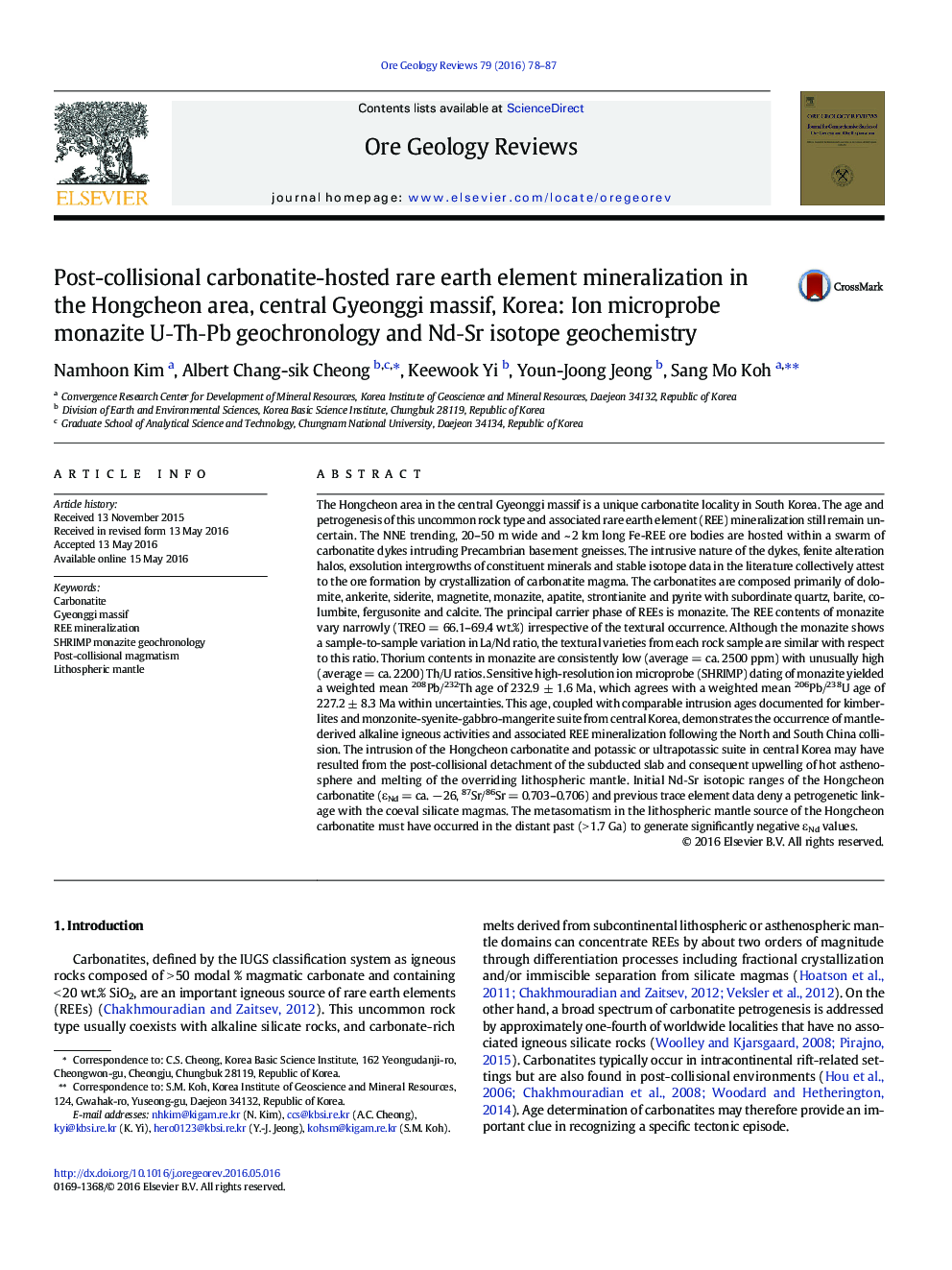| کد مقاله | کد نشریه | سال انتشار | مقاله انگلیسی | نسخه تمام متن |
|---|---|---|---|---|
| 4696787 | 1637227 | 2016 | 10 صفحه PDF | دانلود رایگان |

• REE mineralization is hosted by carbonatite dykes in Hongcheon, central Korea.
• SHRIMP monazite dating yielded a Late Triassic crystallization age.
• The Hongcheon carbonatite and coeval high-K plutons are post-collisional products.
• The Hongcheon carbonatite was derived from an ancient lithospheric mantle.
• Post-collisional carbonatite and silicate magmas in central Korea are not consanguineous.
The Hongcheon area in the central Gyeonggi massif is a unique carbonatite locality in South Korea. The age and petrogenesis of this uncommon rock type and associated rare earth element (REE) mineralization still remain uncertain. The NNE trending, 20–50 m wide and ~ 2 km long Fe-REE ore bodies are hosted within a swarm of carbonatite dykes intruding Precambrian basement gneisses. The intrusive nature of the dykes, fenite alteration halos, exsolution intergrowths of constituent minerals and stable isotope data in the literature collectively attest to the ore formation by crystallization of carbonatite magma. The carbonatites are composed primarily of dolomite, ankerite, siderite, magnetite, monazite, apatite, strontianite and pyrite with subordinate quartz, barite, columbite, fergusonite and calcite. The principal carrier phase of REEs is monazite. The REE contents of monazite vary narrowly (TREO = 66.1–69.4 wt.%) irrespective of the textural occurrence. Although the monazite shows a sample-to-sample variation in La/Nd ratio, the textural varieties from each rock sample are similar with respect to this ratio. Thorium contents in monazite are consistently low (average = ca. 2500 ppm) with unusually high (average = ca. 2200) Th/U ratios. Sensitive high-resolution ion microprobe (SHRIMP) dating of monazite yielded a weighted mean 208Pb/232Th age of 232.9 ± 1.6 Ma, which agrees with a weighted mean 206Pb/238U age of 227.2 ± 8.3 Ma within uncertainties. This age, coupled with comparable intrusion ages documented for kimberlites and monzonite-syenite-gabbro-mangerite suite from central Korea, demonstrates the occurrence of mantle-derived alkaline igneous activities and associated REE mineralization following the North and South China collision. The intrusion of the Hongcheon carbonatite and potassic or ultrapotassic suite in central Korea may have resulted from the post-collisional detachment of the subducted slab and consequent upwelling of hot asthenosphere and melting of the overriding lithospheric mantle. Initial Nd‐Sr isotopic ranges of the Hongcheon carbonatite (εNd = ca. − 26, 87Sr/86Sr = 0.703–0.706) and previous trace element data deny a petrogenetic linkage with the coeval silicate magmas. The metasomatism in the lithospheric mantle source of the Hongcheon carbonatite must have occurred in the distant past (> 1.7 Ga) to generate significantly negative εNd values.
Figure optionsDownload as PowerPoint slide
Journal: Ore Geology Reviews - Volume 79, December 2016, Pages 78–87